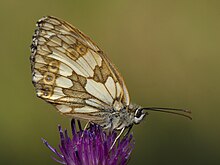Chess board (butterfly)
| Chess board | ||||||||||||
|---|---|---|---|---|---|---|---|---|---|---|---|---|

Chess board ( Melanargia galathea ) |
||||||||||||
| Systematics | ||||||||||||
|
||||||||||||
| Scientific name | ||||||||||||
| Melanargia galathea | ||||||||||||
| ( Linnaeus , 1758) |
The chessboard or checkerboard ( Melanargia galathea ) is a butterfly ( butterfly ) of the subfamily of Julia Butterfly within the family of Nymphalidae (Nymphalidae). The specific epithet is derived from Galatea , a nymph from Greek mythology . The chessboard is a very widespread and variable type and has formed a number of local forms. The moth is butterfly of the year 2019.
features
The moths reach a wingspan of 37 to 52 millimeters. The tops of their wings are spotted black or dark brown and white like a checkerboard. The undersides of the wings are predominantly white to light brown in color and have several gray spots, the edge of which is somewhat darker in color. In the post-fiscal region one can see several black, white-core and wide white-rimmed eye spots . The wing veins are black. There are specimens whose wing underside is almost pure white. There are also very dark shapes (e.g. in Friuli ).
The caterpillars are about 28 millimeters long and are either green or yellow to gray-brown in color. Your head is always light brown. On the back they have a dark longitudinal line, on the sides a side stripe that is light upwards and darker downwards. The end of the abdomen ends in two lobes, which are colored reddish on the upper side. The body of the animals is hairy short.
Occurrence
The animals come from northern Spain across Central Europe and Italy to Eastern Europe . They are also found in North Africa . In the north the distribution area extends to northern Germany and the south of England . In the southeast the species is absent in southern Greece and approximately from the Asian part of Turkey . The vertical distribution extends from sea level to heights of around 1,750 meters. In some places their range is expanding, but there are also areas where their occurrence is declining. The chessboard is common in Central Europe. in southern Germany the chessboard is represented much more frequently than in central and western Germany. It lives in less humid, grassy areas, such as in meadows and clearings and on roadsides and embankments, preferably with calcareous soil. Lean lime lawns on sunny slopes are also preferred locations.
Way of life
The adults often sit on knapweed ( Centaurea ), scabiosa ( Scabiosa ), thistle ( Cirsium ) and ring thistle ( Carduus ) and suck nectar. Male moths have no observation posts, but fly around in search of newly hatched females.
Flight and caterpillar times
The moths fly in one generation from the beginning of June to the end of August, depending on the altitude and climatic conditions. The caterpillars hatch in July / August and overwinter. Since they are nocturnal, they can be found after wintering at night from March to May / June.
Food of the caterpillars
The caterpillars feed on many different types of grass, such as pinnate twinkles ( Brachypodium pinnatum ), upright trespe ( Bromus erectus ), meadow bluegrass ( Poa pratensis ), red ostrich grass ( Agrostis capillaris ), common ball grass ( Dactylis glomerata ), blue grass Pipe grass ( Molinia caerulea ), fluffy meadow oats ( Helictotrichon pubescens ), fescue ( Festuca ) and Zwenken ( Brachypodium ).
development
The females drop their smooth, whitish, round eggs sitting on blades of grass or other plants randomly on the ground. The eggs are significantly larger than those of related species because the young caterpillars need more energy to hibernate after hatching without eating. The caterpillars are nocturnal and feed on various types of grass. They pupate lying on the ground in a loose web. The pupa is whitish or yellowish to ocher brown in color.
swell
Individual evidence
- ^ Arnold Spuler: The butterflies of Europe . tape 1 . E. Schweitzerbartsche Verlagbuchhandlung, Stuttgart 1908, p. 32 .
- ↑ BUND names chessboard butterfly butterfly of the year. Süddeutsche Zeitung , November 22, 2018, accessed on August 25, 2020 .
- ↑ Ernst R. Reichl: The race formation of Melanargia galathea L. in western Friuli (Lep., Satyridae) . - magazine d. Work comm. Austrian Entom., 26th year, 2-4; 33-40, 1975
- ↑ a b c Heiko Bellmann : The new Kosmos butterfly guide. Butterflies, caterpillars and forage plants. Franckh-Kosmos, Stuttgart 2003, ISBN 3-440-09330-1 , p. 194.
- ↑ a b c Tom Tolman, Richard Lewington: Die Tagfalter Europäische und Nordwestafrikas , p. 180, Franckh-Kosmos Verlags-GmbH & Co, Stuttgart 1998, ISBN 3-440-07573-7
- ↑ a b c W. Düring: Schachbrettfalter. In: Species portraits of butterflies in Rhineland-Palatinate. BUND RLP, March 22, 2020, accessed on June 21, 2020 (German).
- ↑ Hans-Josef Weidemann: Tagfalter: watch, determine , p. 516f, Naturbuch-Verlag Augsburg 1995, ISBN 3-89440-115-X
literature
- Günter Ebert and Erwin Rennwald: The Butterflies of Baden-Württemberg Volume 2, Tagfalter II, p. 7ff. Ulmer Verlag Stuttgart 1993. ISBN 3-8001-3451-9
- Steinbach's nature guide: Butterflies , Mosaik Verlag, Munich 1983, ISBN 3-576-01272-9
Web links
- Lepiforum e. V. Taxonomy and Photos
- Species portraits of butterflies in Rhineland-Palatinate - chessboard butterflies
- www.schmetterling-raupe.de
- Moths and Butterflies of Europe and North Africa (English)
- Melanargia galathea in Fauna Europaea



